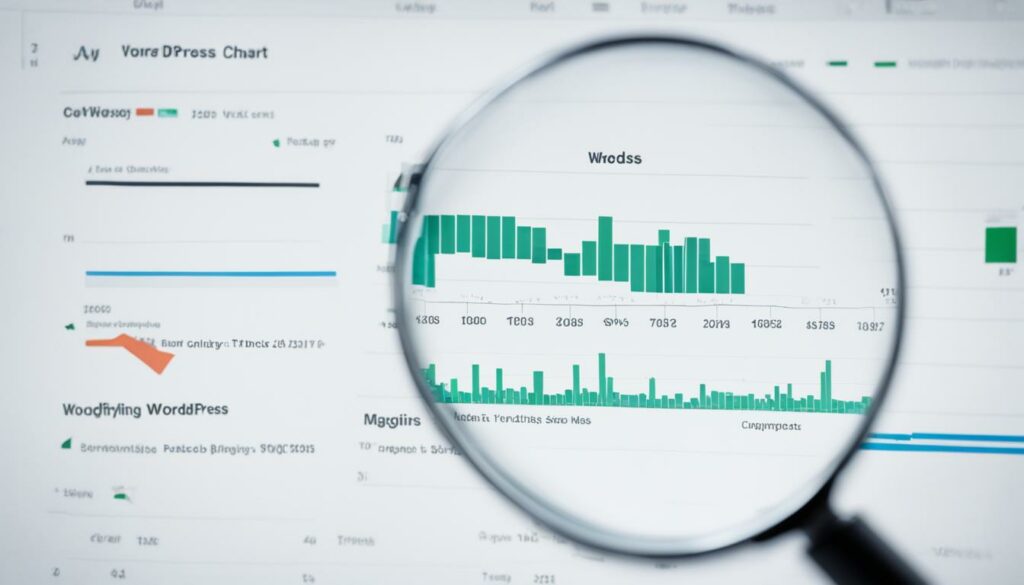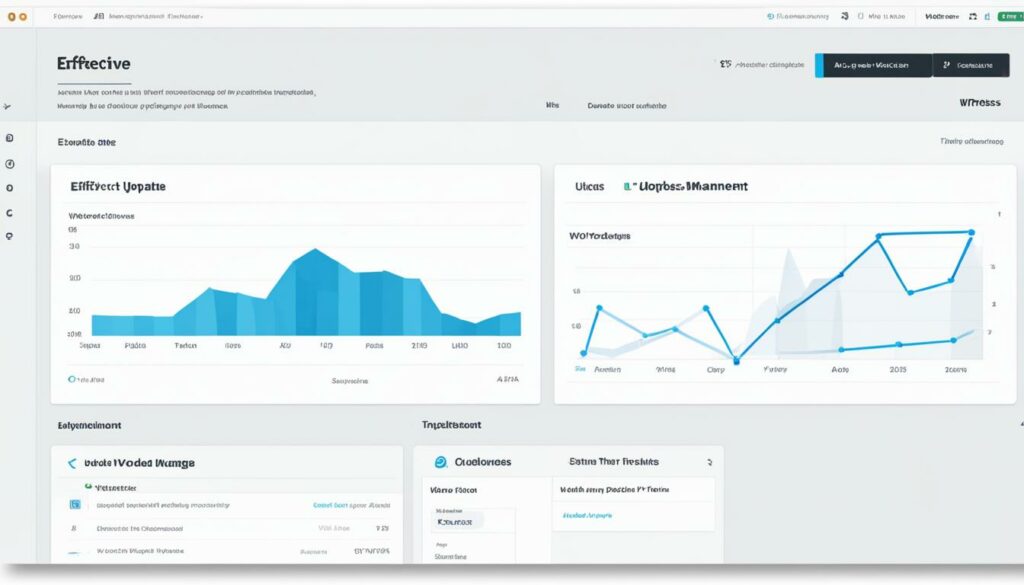Welcome to our article on WordPress update management! If you’re a WordPress website owner, it’s crucial to stay on top of updates for your themes and plugins. Regular updates enhance security, improve performance, and ensure compatibility with the latest version of WordPress.
However, managing updates can be a challenge, especially when dealing with multiple themes and plugins. That’s why we’re here to help you navigate the world of WordPress updates and provide you with effective strategies for tracking theme and plugin updates.
Key Takeaways:
- Regular updates are important for WordPress security, performance, and compatibility.
- Check for updates at least once a week to stay informed.
- Effectively manage theme updates by checking regularly, backing up your website, and testing updates on a staging site.
- Streamline plugin updates by monitoring notifications, assessing release notes, verifying compatibility, and implementing updates in a controlled manner.
- Consider using the WordPress Update Tracker plugin for automatic notifications and streamlined update management.
Why are WordPress theme and plugin updates important?
WordPress theme and plugin updates play a crucial role in ensuring the security, performance, and compatibility of your website. By regularly updating your WordPress themes and plugins, you can address security vulnerabilities, enhance the performance of your website, and ensure compatibility with the latest version of WordPress.
When it comes to WordPress security, updates are essential. Developers constantly identify and fix security vulnerabilities in themes and plugins. By updating to the latest versions, you can protect your website from potential cyber threats and keep your visitors’ sensitive information secure.
Updates also help optimize the performance of your WordPress website. As new updates are released, developers often introduce performance improvements and fix bugs that can affect the speed and functionality of your site. Regularly updating your themes and plugins ensures that your website runs smoothly, providing a positive user experience.
Compatibility is another key aspect of WordPress updates. With each WordPress release, there may be changes to the core software that affect how themes and plugins interact with your website. By staying up to date with theme and plugin updates, you can ensure that everything on your site remains compatible, preventing any issues or conflicts that may arise.
Overall, WordPress theme and plugin updates are vital for maintaining a secure, high-performing, and compatible website. By prioritizing regular updates, you can protect your website from security threats, enhance its performance, and ensure its compatibility with the latest version of WordPress.
How often should I check for WordPress updates?
Regularly checking for WordPress updates is essential to ensure the security and performance of your website. It is recommended to check for updates at least once a week. Staying on top of WordPress updates helps you stay informed about the latest features, bug fixes, and security patches.
By checking for updates regularly, you can stay ahead of any potential vulnerabilities and ensure your website remains secure. Applying updates promptly is crucial for protecting your website from potential security breaches and keeping your data safe.
One way to simplify the process of checking for updates is by using the WordPress Update Tracker plugin. This plugin consolidates all available updates into a single, easily accessible dashboard, making it convenient for you to stay updated.
Remember, staying proactive with your WordPress updates not only enhances the security and performance of your website, but it also ensures compatibility with the latest WordPress version. Neglecting updates can lead to compatibility issues and may even result in your website becoming vulnerable to security threats.
Benefits of Regularly Checking for WordPress Updates:
- Enhanced security
- Improved website performance
- Compatibility with the latest version of WordPress
- Access to new features and bug fixes
Make it a habit to schedule regular check-ins for WordPress updates to ensure your website remains up-to-date and optimized.
How to Effectively Manage Theme Updates
Managing theme updates is a critical aspect of maintaining a secure and optimized WordPress website. By following best practices, you can ensure that your themes stay up to date with the latest features, bug fixes, and security patches. Here are some effective strategies to help you manage theme updates:
- Regularly Check for Theme Updates: Stay proactive by regularly checking for theme updates. Most theme developers release updates periodically to address security vulnerabilities, improve performance, and introduce new features. By keeping an eye on update notifications, you can ensure timely updates for your themes.
- Backup Your Website Before Updating: Before applying any theme updates, it’s essential to create a backup of your website. This precaution ensures that you can restore your site to its previous state if any compatibility issues or errors arise during the update process. Utilize reliable backup solutions or plugins to automate this process.
- Test Updates on a Staging Site: It’s advisable to test theme updates on a staging site before deploying them to your live website. A staging site is a replica of your website that allows you to experiment with theme updates without impacting the performance or functionality of your live site. This testing phase helps identify any issues and allows you to address them before updating your live site.
- Update Child Themes and Customizations: If you are using a child theme or have made customizations to your theme’s code, it’s crucial to ensure that these modifications are compatible with the updated parent theme. Failure to update child themes and customizations may result in compatibility issues or the loss of specific functionalities. Test and update child themes and customizations accordingly to maintain a consistent and secure website.
By implementing these best practices, you can effectively manage theme updates and keep your WordPress website running smoothly. Don’t neglect theme updates as they contribute to enhanced security, improved performance, and extended compatibility.
If you want to further optimize your WordPress website’s performance and ensure reliable updates, we recommend WordPress Hosting from BoostedHost. Sign up now through this link: www.boostedhost.com/wordpress-hosting.
“Managing theme updates is crucial for maintaining a secure and optimized WordPress website.”
| Best Practices | Description |
|---|---|
| Regularly Check for Theme Updates | Stay informed about the latest theme updates by regularly checking for notifications or visiting the theme developer’s website. |
| Backup Your Website Before Updating | Create a backup of your website to ensure you can restore it in case any compatibility issues or errors occur during the update process. |
| Test Updates on a Staging Site | Before updating your live site, test theme updates on a staging site to identify and address any issues or conflicts with your existing setup. |
| Update Child Themes and Customizations | If you use a child theme or have made customizations, ensure they are compatible with the updated parent theme to avoid any compatibility issues. |
“Implement these best practices to effectively manage theme updates and ensure a secure and optimized WordPress website.”
How to Streamline the Process of Managing Plugin Updates
Managing plugin updates is an essential part of maintaining a secure and optimized WordPress website. By staying up-to-date with the latest plugin updates, you can ensure enhanced security, improved functionality, and compatibility with the latest version of WordPress.
To streamline the process of managing plugin updates, consider the following best practices:
- Monitor plugin update notifications: Stay informed about available updates by regularly checking for notifications within your WordPress dashboard or using reliable plugins that provide update alerts.
- Assess update release notes: Before applying any updates, take the time to read the release notes provided by plugin developers. This will give you crucial information about bug fixes, security patches, and new features.
- Verify plugin compatibility: Some plugins may not be compatible with the latest version of WordPress or other plugins you have installed. Before proceeding with an update, verify compatibility to avoid potential conflicts or issues on your website.
- Implement updates in a controlled manner: It’s good practice to test plugin updates on a staging site or in a controlled environment before applying them to your live website. This helps prevent any unexpected issues or conflicts from affecting your site’s functionality.
By following these best practices, you can ensure a smooth and efficient process for managing plugin updates, reducing the likelihood of compatibility issues and other potential setbacks.
Remember to always back up your website before applying any updates, as an extra precaution to safeguard your data.

Streamlining the process of managing plugin updates can save you time and ensure the security and optimal performance of your WordPress website.
The benefits of using the WordPress Update Tracker plugin
As a WordPress user, staying on top of updates is essential for maintaining the security and performance of your website. The WordPress Update Tracker plugin is a valuable tool that simplifies the process of tracking and implementing updates. Whether you’re managing a single website or multiple sites, this plugin offers a range of benefits to streamline your update management.
Automatic update notifications
With the WordPress Update Tracker plugin, you’ll receive automatic notifications whenever updates are available for your themes and plugins. This ensures that you’re always aware of the latest updates and can promptly address any security vulnerabilities or performance improvements.
Consolidated view of available updates
Gone are the days of manually checking each theme and plugin for updates. The WordPress Update Tracker plugin provides a consolidated view of all available updates in one convenient location. This saves you time and effort by presenting an overview of the updates, allowing you to prioritize and apply them efficiently.
One-click update implementation
Updating themes and plugins can be a time-consuming process, especially when dealing with multiple sites. The WordPress Update Tracker plugin streamlines this task with its one-click update implementation feature. Simply click a button, and the plugin will handle the update process for you, ensuring a seamless and hassle-free experience.
Customizable update schedules
The plugin also allows you to customize your update schedules according to your preferences. Whether you prefer to update immediately upon availability or schedule updates during specific hours, you have the flexibility to tailor your update process to suit your needs.
Detailed update logs and history
With the WordPress Update Tracker plugin, you have access to detailed update logs and history. This enables you to track the changes made during each update, ensuring transparency and accountability. You can easily review previous updates and reference them if needed.
By utilizing the WordPress Update Tracker plugin, you can effectively manage and keep your WordPress themes and plugins up to date. This, in turn, helps to maintain the security, performance, and compatibility of your website. Sign up for BoostedHost’s WordPress Hosting service to optimize your website performance and access the benefits of the WordPress Update Tracker plugin. Stay ahead of updates and ensure your website remains secure and up to date.
| Features | WordPress Update Tracker Plugin |
|---|---|
| Automatic update notifications | ✓ |
| Consolidated view of available updates | ✓ |
| One-click update implementation | ✓ |
| Customizable update schedules | ✓ |
| Detailed update logs and history | ✓ |

Alternative methods for tracking updates
While the WordPress Update Tracker plugin is an excellent tool for tracking updates, there are alternative methods you can use to stay on top of the latest developments. These methods include utilizing update tracking services and manually tracking updates using reliable sources.
Update tracking services
If you prefer a more hands-off approach to tracking updates, you can consider using update tracking services. These services provide regular notifications and updates on the latest releases for your favorite WordPress themes and plugins. By subscribing to these services, you can stay informed without having to manually check for updates yourself.
Manual tracking methods
If you prefer a more hands-on approach and want full control over the update tracking process, manual tracking methods may be more suitable for you. This involves visiting the websites of theme and plugin developers directly or subscribing to their newsletters for update announcements. By doing so, you can ensure that you’re always aware of the latest updates and can take action accordingly.
Here’s a breakdown of the pros and cons of each method:
| Method | Pros | Cons |
|---|---|---|
| Update Tracking Services |
|
|
| Manual Tracking Methods |
|
|
Ultimately, the method you choose depends on your personal preference and the specific needs of your website. Whether you opt for update tracking services or manual tracking methods, the key is to ensure that you’re relying on reliable sources for tracking updates. This will help you stay up to date with the latest releases, enhancing the security, performance, and compatibility of your WordPress website.

Sign up for BoostedHost’s WordPress Hosting to optimize your website performance. Don’t miss out on the latest updates! Sign up now.
The Risks of Neglecting WordPress Updates
Neglecting to update your WordPress themes and plugins can expose your website to various risks, including security vulnerabilities, compatibility issues, and performance degradation. By failing to keep your themes and plugins up to date, you leave your website susceptible to potential attacks and compromises on its security.
Outdated themes and plugins may contain known security vulnerabilities that hackers can exploit to gain unauthorized access to your website or sensitive user data. These vulnerabilities are often discovered by developers through continuous testing and improvement, and patches or updates are released to address these security risks.
Furthermore, compatibility issues may arise as WordPress releases updates to its core software. Themes and plugins that are not regularly updated can become incompatible with the latest version of WordPress. This can lead to broken functionality, layout issues, or even complete website downtime.
Finally, failing to update your themes and plugins can result in performance degradation. Updates often include optimizations and bug fixes that improve the speed and performance of your website. Without these updates, your website may become slower and less responsive, negatively impacting the user experience.
“Updating your WordPress themes and plugins is not just a matter of staying current; it’s a crucial step in maintaining the security, compatibility, and performance of your website.”
The Importance of Regular Updates
To mitigate these risks, it is essential to prioritize regular updates for your WordPress themes and plugins. By keeping them up to date, you ensure that your website remains secure, compatible with the latest WordPress version, and optimized for performance. Stay proactive in managing your website’s updates to safeguard against potential vulnerabilities and ensure a seamless user experience.
Next, we’ll explore the best practices for effectively managing theme updates and streamlining the process of handling plugin updates.
The importance of choosing reliable sources for updates
When you manually track updates for your WordPress themes and plugins, it is crucial to rely on reliable sources to ensure the security and compatibility of your website. Choosing trustworthy sources safeguards your website from potential security risks and compatibility issues that may arise from applying updates from unverified or untrusted sources.
Reputable sources for WordPress updates provide accurate and vetted information about theme and plugin updates, ensuring they are safe to install and won’t introduce any additional vulnerabilities or conflicts to your website.
Remember, the security of your website relies on the integrity of the updates you apply. By choosing reliable sources, you minimize the risk of compromising the security and stability of your WordPress site.
The characteristics of reliable sources
Reliable sources for WordPress updates exhibit the following characteristics:
- Trustworthy reputation within the WordPress community
- Regularly updated information and prompt release notifications
- Detailed release notes and changelogs
- Positive user reviews and feedback
- A strong track record of providing accurate updates
By selecting reputable sources that meet these criteria, you can have confidence in the updates you apply and ensure the continued security and optimal performance of your WordPress website.
An example of reliable sources:
| Source | Description | Website |
|---|---|---|
| WordPress.org | The official website of the WordPress project, providing trusted information and updates on WordPress themes and plugins. | wordpress.org |
| ThemeForest | A popular marketplace for WordPress themes, offering a wide selection of themes from reputable developers. | themeforest.net |
| Plugin Directory | The official directory of WordPress plugins, where developers submit their plugins for review and inclusion in the WordPress repository. | wordpress.org/plugins |
| Developer Websites | The websites of theme and plugin developers, where they provide update notifications, release notes, and direct download links for updates. | Varies based on developers |
Remember to verify the source and credibility of any updates before applying them to your WordPress website. By choosing reliable sources for updates, you can maintain the security, compatibility, and overall performance of your WordPress themes and plugins.
Conclusion
Managing your WordPress updates is essential for maintaining a secure, high-performing, and compatible website. By implementing effective update tracking strategies and using tools like the WordPress Update Tracker plugin, you can streamline the process and ensure your website stays up-to-date.
Regularly checking for updates is crucial to stay informed about the latest security patches, bug fixes, and feature enhancements. Testing updates on staging sites before implementing them on your live website helps minimize the risk of compatibility issues.
It’s also important to prioritize your update management and not ignore updates. Neglecting updates can leave your website vulnerable to security breaches, cause compatibility issues with the latest version of WordPress, and lead to performance degradation.
BoostedHost offers top-notch WordPress hosting services, providing optimal performance and support for your website needs. Sign up now through this link to experience the benefits of a reliable hosting solution.
FAQ
Q: Why are WordPress theme and plugin updates important?
A: WordPress theme and plugin updates are important because they address security vulnerabilities, enhance performance, and ensure compatibility with the latest version of WordPress. Regular updates to WordPress themes and plugins are essential to ensure the security and functionality of your website. By regularly updating your themes and plugins, you can ensure that your website remains secure, functions smoothly, and stays compatible with new WordPress releases.
Q: How often should I check for WordPress updates?
A: It is recommended to check for WordPress updates regularly, at least once a week. This helps you stay informed about the latest updates and apply them promptly.
Q: How to effectively manage theme updates?
A: To effectively manage theme updates, consider the following best practices: regularly checking for theme updates, backing up your website before updating, testing updates on a staging site, updating child themes and customizations.
Q: How to streamline the process of managing plugin updates?
A: To streamline the process of managing plugin updates, consider the following strategies: monitoring plugin update notifications, assessing update release notes, verifying plugin compatibility, implementing updates in a controlled manner.
Q: What are the benefits of using the WordPress Update Tracker plugin?
A: The WordPress Update Tracker plugin offers a range of features designed to simplify the update tracking process. This includes automatic update notifications, a consolidated view of available updates, one-click update implementation, customizable update schedules, and detailed update logs and history.
Q: What are the alternative methods for tracking updates?
A: Apart from the WordPress Update Tracker plugin, there are alternative methods for tracking updates, such as using update tracking services or manually tracking updates by visiting the websites of theme and plugin developers or subscribing to their newsletters for update announcements.
Q: What are the risks of neglecting WordPress updates?
A: Neglecting to update your WordPress themes and plugins can have severe consequences, including security vulnerabilities, compatibility issues, and performance degradation. Outdated themes and plugins may contain known security vulnerabilities that can be exploited by hackers, causing potential risks to your website and user data.
Q: Why is it important to choose reliable sources for updates?
A: When manually tracking updates, it is crucial to rely on reputable sources to avoid potential security risks or compatibility issues. Choosing reliable sources ensures that the updates you apply to your themes and plugins are trustworthy and won’t introduce any additional vulnerabilities or conflicts.












